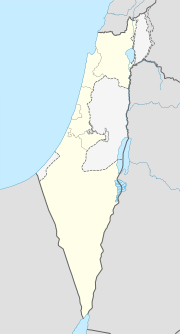"al-Quds" redirects here. For other uses, see al-Quds (disambiguation).
For other uses, see Jerusalem (disambiguation).
| Jerusalem | |||
 Modern Jerusalem | |||
| |||
| District | Jerusalem | ||
| Government | City | ||
| Hebrew | יְרוּשָׁלַיִם | ||
| (Translit.) | Yerushalayim | ||
| Arabic | commonly القـُدْس (Al-Quds); officially in Israel أورشليم القدس (Urshalim-Al-Quds) | ||
| Name meaning | Hebrew: (see below), Arabic: "The Holy" | ||
| Population | 763,600[1] Israeli Metropolitan Area: 1,029,300 (2009) | ||
| Area | 125,156 dunams (125.156 km2; 48.323 sq mi) | ||
| Mayor | Nir Barkat | ||
| Coordinates | 31°47′N 35°13′E / 31.783°N 35.217°ECoordinates: 31°47′N 35°13′E / 31.783°N 35.217°E | ||
| Website | www.jerusalem.muni.il[i] | ||
The city has a history that goes back to the 4th millennium BCE, making it one of the oldest cities in the world.[5] Jerusalem is the holiest city in Judaism and Christianity and has been the spiritual center of the Jewish people since c. 1000 BCE, when David the King of Israel first established it as the capital of the Jewish Nation, and his son Solomon commissioned the building of the First Temple in the city.[6] Jerusalem contains a number of significant Christian sites, and due to the mentioning of the Al-Aqsa-Mosque and the blessed earth around it in the Qur'an (Sura al-Isra), Islam regards Jerusalem as its third-holiest city.[7] Despite having an area of only 0.9 square kilometer (0.35 square mile),[8] the Old City is home to sites of key religious importance, among them the Temple Mount, the Western Wall, the Church of the Holy Sepulchre, the Dome of the Rock and al-Aqsa Mosque. The old walled city, a World Heritage site, has been traditionally divided into four quarters, although the names used today—the Armenian, Christian, Jewish, and Muslim Quarters—were introduced in the early 19th century.[9] The Old City was nominated for inclusion on the List of World Heritage Sites in danger by Jordan in 1982.[10] In the course of its history, Jerusalem has been destroyed twice, besieged 23 times, attacked 52 times, and captured and recaptured 44 times.[11]
Today, the status of Jerusalem remains one of the core issues in the Israeli-Palestinian conflict. Israel's annexation of East Jerusalem has been repeatedly criticized by the United Nations and related bodies,[12][13] and Palestinians demand East Jerusalem as the capital of their future state.[14][15] In the wake of United Nations Security Council Resolution 478 (passed in 1980), most foreign embassies moved out of Jerusalem.[16]





No comments:
Post a Comment